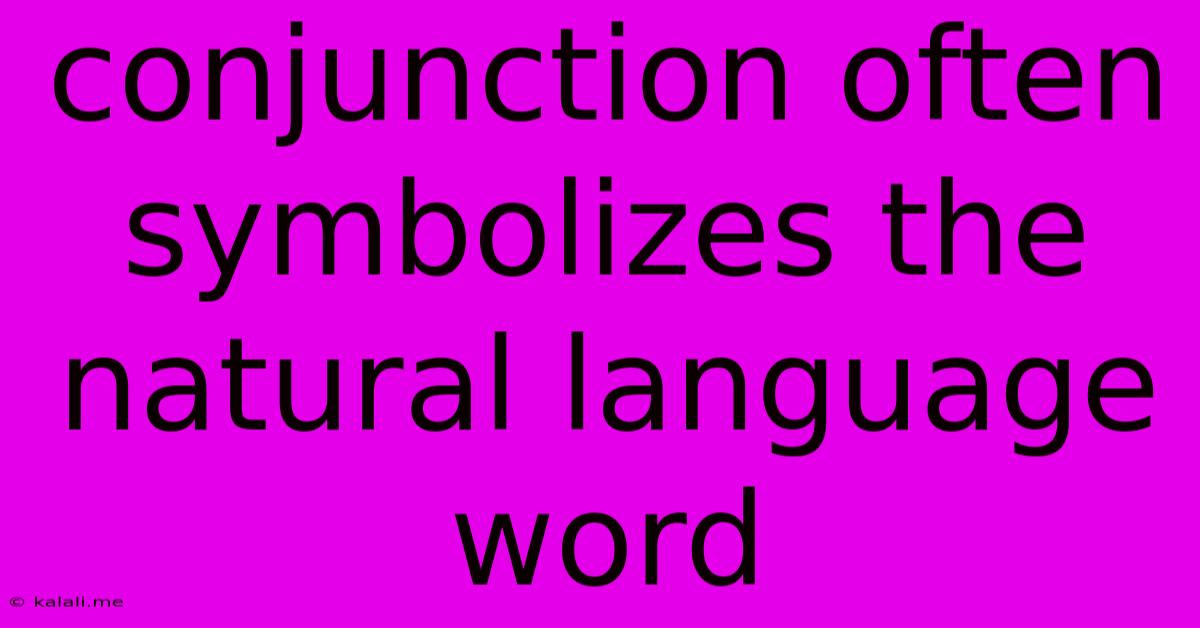Conjunction Often Symbolizes The Natural Language Word
Kalali
May 30, 2025 · 3 min read

Table of Contents
Conjunctions: The Unsung Heroes of Natural Language Processing
Conjunctions, those seemingly small words like "and," "but," and "or," are often overlooked. Yet, they are crucial components of natural language, acting as the glue that binds sentences and clauses together, shaping meaning and influencing the overall structure of text. Understanding their role is vital for anyone working in natural language processing (NLP) or striving to improve their writing. This article will explore the multifaceted role of conjunctions in natural language, highlighting their importance and demonstrating how they impact both human understanding and machine interpretation.
What are Conjunctions?
Conjunctions are words that connect words, phrases, clauses, or sentences. They show relationships between the elements they join, indicating addition, contrast, cause and effect, or other logical connections. Failing to correctly identify and interpret conjunctions can lead to misinterpretations of the entire text. Therefore, accurate conjunction identification and classification is a key challenge and an active area of research within NLP.
Types of Conjunctions and Their Semantic Roles:
Conjunctions are broadly categorized into several types, each conveying a distinct semantic relationship:
-
Coordinating Conjunctions: These join words, phrases, or clauses of equal grammatical rank. The most common are "and," "but," "or," "nor," "for," "so," and "yet." "And" signifies addition, "but" indicates contrast, "or" presents alternatives, and so on. The nuance conveyed by these words is subtle but significant. For example, "The cat sat on the mat and the dog barked" suggests a temporal sequence or simple co-occurrence, whereas "The cat sat on the mat but the dog barked" implies a contrast or unexpected event.
-
Subordinating Conjunctions: These introduce a dependent clause, making it grammatically subordinate to the main clause. Examples include "because," "although," "since," "if," "unless," "while," "before," "after," "until," and "as." These conjunctions establish a hierarchical relationship between clauses, specifying the logical relationship between them. For example, "Because it was raining, the game was cancelled" establishes causality.
-
Correlative Conjunctions: These conjunctions work in pairs to connect words or phrases, such as "both...and," "either...or," "neither...nor," and "not only...but also." They highlight a parallel structure and emphasize the relationship between the connected elements. For instance, "Both the cat and the dog were playing" clearly connects two subjects with parallel actions.
Challenges in NLP Related to Conjunctions:
Despite their apparent simplicity, conjunctions pose significant challenges in NLP due to their:
- Ambiguity: The same conjunction can have different meanings depending on the context. For example, "or" can indicate exclusivity ("choose either A or B") or inclusivity ("you can have tea or coffee, or both").
- Implicit Relationships: Sometimes, the relationships between clauses are implied rather than explicitly stated through conjunctions. This requires sophisticated NLP techniques to infer the connections.
- Discourse Structure: Conjunctions play a critical role in establishing the overall discourse structure of a text, affecting the coherence and flow of information. Understanding this structure is crucial for tasks like text summarization and question answering.
Conclusion:
Conjunctions, despite their seemingly simple nature, are fundamental to the structure and meaning of natural language. Their correct identification and interpretation are crucial for effective natural language processing. Researchers continue to develop advanced NLP techniques to better understand and model the subtle nuances and complexities of these "unsung heroes" of language. A deeper appreciation of conjunctions is essential for both human writers and for the development of more sophisticated and accurate NLP systems.
Latest Posts
Latest Posts
-
Gallons Per Minute From A Spicket
May 31, 2025
-
What Size Aluminum Cable For 100 Amp Meter
May 31, 2025
-
Delete Directory In Linux Not Empty
May 31, 2025
-
Can You Hold An Action On A Banished Creature
May 31, 2025
-
How To Mount Grab Bar On Fiberglas Shower Enclosure
May 31, 2025
Related Post
Thank you for visiting our website which covers about Conjunction Often Symbolizes The Natural Language Word . We hope the information provided has been useful to you. Feel free to contact us if you have any questions or need further assistance. See you next time and don't miss to bookmark.